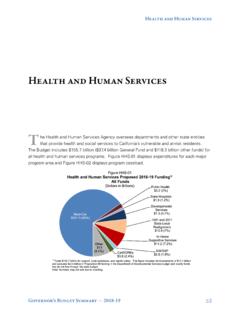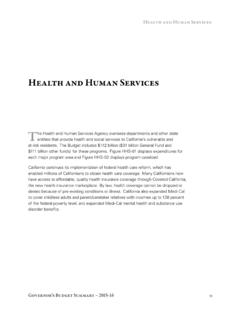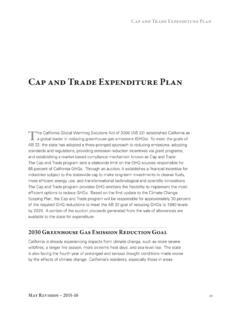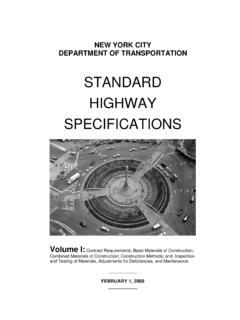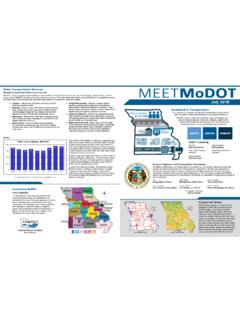Transcription of California Five-Year Infrastructure Plan 2016
1 California Five-Year Infrastructure plan 2016. Edmund G. Brown Jr. Governor State of California This page intentionally blank to facilitate double-sided printing. Table of Contents 2016 Five-Year Infrastructure plan Table of C ontents Introduction.. 1. Overview of the plan .. 1. Maintenance of Existing Infrastructure .. 3. The Capitol and Central Sacramento Office Space .. 6. Affordability and Debt Management .. 7. Integrating Climate Change into Planning.. 9. Infrastructure plan .. 11. Judicial Branch.. 11. Transportation Agency.. 15. Department of Transportation.. 16. High Speed Rail Authority.. 19. California Highway Patrol.. 20. Department of Motor Vehicles.. 23. Natural Resources Agency.
2 24. State Conservancies and the Wildlife Conservation Board.. 26. California Conservation Corps.. 27. Department of Forestry and Fire Protection .. 28. Department of Fish and Wildlife .. 31. Department of Parks and Recreation.. 33. Department of Water Resources.. 35. California Environmental Protection Agency .. 39. Air Resources Board .. 40. Health and Human Services Agency.. 41. Department of Developmental Services.. 41. Department of State Hospitals .. 43. Department of Corrections and Rehabilitation.. 46. K Thru 12 Education.. 50. K Thru 12 School Facilities.. 50. State Special Schools.. 53. Higher Education .. 55. Hastings College of the Law.. 57. Government Operations Agency.
3 57. Department of Technology .. 58. Department of General Services.. 59. General Government .. 61. Office of Emergency Services.. 62. Department of Food and Agriculture.. 63. Military Department.. 65. Appendices.. 69. 1 Proposed 2016 Five-Year Infrastructure Funding .. 69. 2 History of California Bonds by Program Area.. 73. 3 History of California Bonds by Date of Authorization .. 77. 4 Authorized and Outstanding General Obligation Bonds.. 81. 5 State Public Works Board and Other Lease-Purchase Financing Outstanding Issues.. 83. 6 Authorized but Unissued Lease Revenue Bonds.. 85. 2016 Five-Year Infrastructure plan iii This page intentionally blank to facilitate double-sided printing.
4 Introduction Introduction T he California Infrastructure Planning Act requires the Governor to submit a five year Infrastructure plan to the Legislature for consideration with the annual budget bill. The 2016 five year Infrastructure plan ( plan ) reflects the Governor's proposal for investing $55 billion in state Infrastructure over the next five years. Relative to years past, the Budget reflects the state's improving finances. This year 's plan , therefore, reflects the expenditure of several billion dollars from the General Fund on long overdue Infrastructure investments. The Budget allocates more than $800 million ($500 million General Fund) for deferred maintenance projects at levees, state facilities, courts, universities, and community colleges.
5 In addition, the Budget allocates $ billion General Fund as a down payment on renovating the state's Sacramento downtown office space, including the State Capitol Annex. The plan also reflects the Governor's transportation package first outlined last summer that will provide $36 billion over the next decade to improve the maintenance of highways and roads, expand public transit, and improve critical trade routes. Making these investments now will reduce the need for even more expensive projects later, and a pay as you go approach will reduce General Fund borrowing costs by more than $ billion in the coming years. Overview of the plan The investment in physical Infrastructure is a core function of state government.
6 Infrastructure and capital assets allow for the delivery of key public services and the movement of goods across the state both essential components in fostering the state's 2016 Five-Year Infrastructure plan 1. Introduction long term economic growth. There continues to be critical deficiencies in the state's Infrastructure , including a significant backlog of maintenance on existing facilities that has built up over years of underfunding. The state must also do more to protect critical Infrastructure and plan for the impacts of climate change. The vast majority of the funding proposed in this plan is dedicated to the state's transportation system more than 91 percent. This reflects the sheer size of the state's system, the state's commitment to building the first high speed rail system in the United States, and a proposed funding plan to enhance the maintenance of the state's roads and highways.
7 The plan proposes a significant investment of $ billion General Fund to improve or replace deteriorated state office space in central Sacramento, including the State Capitol Annex. The plan includes significant expenditures from the Water Quality, Supply, and Infrastructure Improvement Act of 2014 (Proposition 1) to help address many goals of the Water Action plan . Additionally, there is continued investment in trial court facilities, the state parks, facilities that support the California Highway Patrol, the Department of Motor Vehicles, and other departments. Budget challenges over the past decade resulted in a greater reliance on debt financing, rather than pay as you go spending.
8 From 1974 to 1999, California voters authorized $ billion of general obligation bonds. Since 2000, voters expanded the types of programs funded by bonds and authorized more than $ billion of general obligation bonds. Of all previously approved Infrastructure bonds, $ billion ($76 billion of general obligation bonds and $ billion of lease revenue bonds) in debt remains outstanding. Additionally, there are $ billion of general obligation and lease revenue bonds ($ billion and $ billion, respectively) that are authorized but not yet issued. The bonds will be issued when projects are approved and ready for construction. The increasing reliance on borrowing to pay for Infrastructure has meant that roughly one out of every two dollars spent on Infrastructure investments goes to pay interest costs, rather than construction costs.
9 The amount of funds required to service the debt has steadily increased over the past years. Annual expenditures on debt service have steadily grown from $ billion in 2000 01 to $ billion in 2015 16. With an improving economy and a significant increase in General Fund revenues, this year provides an opportunity to put aside a significant amount of one time funds to invest in Infrastructure . The Budget proposes a $ billion transfer from the General Fund to a new State Office Infrastructure Fund to be used for the renovation or replacement of state office buildings 2 2016 Five-Year Infrastructure plan Introduction in the Sacramento region. The $ billion will make a significant investment towards the overall plan to improve or replace inadequate state office space in central Sacramento.
10 This plan proposes $55 billion in spending. Of this amount, $705 million is from the General Fund, $9 billion is from various special funds, $ billion is from lease revenue bond funds, $350 million is from general obligation bond funds, $ billion is from federal funds, $ billion is from reimbursements and other non governmental cost funds, and $ billion is from High Speed Rail funds. See Figure INO 01 for a summary of the proposed funding. A detailed listing of the specific projects proposed to be funded can be found in Appendix 1. Appendix 1 also identifies the cost of the projects, the phase of the project to be funded, and whether the project is new or continuing. Figure INO-01.

